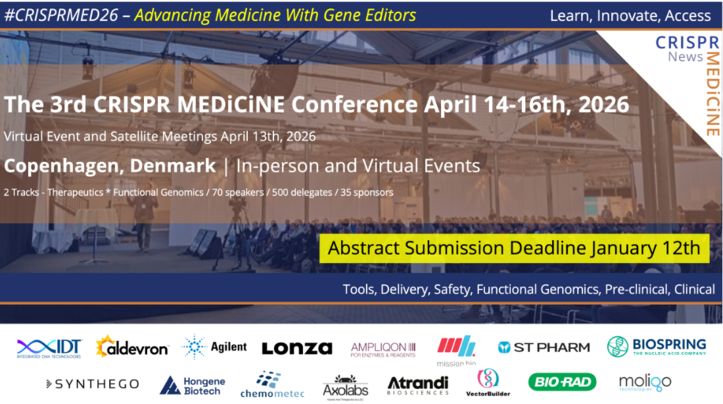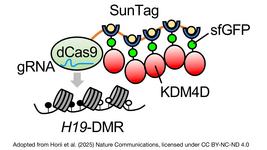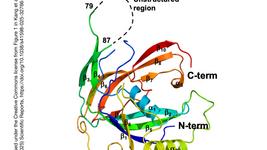CMN Weekly (18 July 2025) - Your Weekly CRISPR Medicine News
By: Gorm Palmgren - Jul. 18, 2025
Top picks
- An American study presents a CRISPR-Cas9-enabled system for both random access and similarity search in DNA-based data storage. By designing Cas9-targetable addresses, the authors achieved selective, multiplexed retrieval from a pool of 1.6 million DNA strands, significantly enriching targeted files for nanopore sequencing. They also developed a machine learning-guided encoder to map 1.74 million images into Cas9-recognisable DNA sequences. Exploiting Cas9’s off-target activity, the system retrieved semantically related image clusters in vitro. This platform enables scalable, rapid, and energy-efficient access to molecular data, marking a key advance in content-aware DNA storage technologies.
- Researchers in Thailand have demonstrated that CRISPR-Cas9 disruption of BCL11A or ZBTB7A/LRF binding sites reactivates fetal haemoglobin in β0-thalassaemia/HbE cells with similar efficacy. Editing efficiency was higher for BCL11A, which also showed no off-target effects, unlike ZBTB7A/LRF. Both edits preserved erythroid differentiation, supporting either site as a viable therapeutic target for γ-globin reactivation in β0-thalassaemia/HbE.
Research
- Using inducible CRISPR-Cas9, researchers showed that Ewing sarcoma metastases rely on intact NPY5R signalling. Knockout of Y5R blocked extrapulmonary spread in xenografts, while metastases arose only from Y5R-positive clones. Mechanistically, NPY-induced RhoA activation enhanced motility via an autocrine or exogenous NPY/Y5R loop. These findings establish NPY/Y5R as a critical driver of ES dissemination and a potential therapeutic target for the treatment of ES.
- A CRISPR-Cas9 system targeting the prevalent FSC 36/37 (−T) HBB mutation in Iran achieved precise genome correction via homology-directed repair in 30% of HEK293 clones and 23.91% of HSC clones. The study validated guide specificity and editing efficacy, supporting this tailored approach as a viable therapeutic strategy for regional beta-thalassaemia variants.
- Researchers in South Korea have used base editing to generate retinoblastoma-like cell lines with mono- and bi-allelic RB1 nonsense mutations (R552X), replicating patient-relevant variants. The edited lines showed reduced RB1 expression and increased proliferation. Subsequent correction using adenine base editing restored expression, demonstrating the utility of precision gene editing for modelling and potentially treating RB1-driven cancers.
- Using CRISPR-dCas9-TET1 and -DNMT3A, researchers have causally linked DNA methylation at the IL1RN promoter to gene expression and the fate of immune cells. Epigenetic editing of this locus altered human myeloid responses to inflammation and infection, demonstrating that targeted methylation changes can modulate immune function and offer a potential strategy for treating inflammation-driven diseases.
- A combined strategy utilising Polq knockdown and AZD7648 treatment redirects DNA repair toward MMEJ, dramatically enhancing CRISPR knock-in efficiency in mouse embryos. This method achieved up to 90% efficiency across diverse loci, offering a universal solution to overcome variability in sgRNA-dependent integration and advancing precise gene editing applications.
- Researchers have developed two CRISPR-based platforms, CREDITS and scCREDIT-seq, to identify regulators of A-to-I RNA editing. Screening 1,350 RNA-binding proteins revealed DDX39B as a global suppressor, acting via its helicase function. DDX39B inhibition enhanced the efficacy of ADAR-dependent tools and disrupted HDV RNA editing, highlighting both a key regulatory mechanism and novel strategies to improve RNA-editing therapeutics.
Screening
- A CRISPR activation screen of 1,603 human transcription factors identified ZIM3 and ZNF394 as key regulators of major zygotic genome activation. Overexpression induced totipotent features in hEPSCs, while knockdown blocked embryo development before the eight-cell stage. Their KRAB domains suppressed four-cell-enriched genes, revealing an unrecognised role for KRAB-containing TFs in early human embryogenesis.
- Inducible CRISPR interference screens in hiPS cells and their neural and cardiac derivatives revealed that translation quality control is cell-type specific. While core translation components are universally essential, stem cells uniquely depend on ribosome rescue pathways and ZNF598 to resolve collisions at translation start sites. These findings highlight how translational surveillance mechanisms are shaped by cell identity during human development.
Clinical and preclinical
- YolTech Therapeutics has announced that the Chinese National Medical Products Administration has approved its IND application for YOLT-101 in heterozygous familial hypercholesterolemia. YOLT-101 is a novel base-editing therapeutic candidate designed to permanently disrupt the PCSK9 gene in the liver to reduce disease-driving low-density lipoprotein cholesterol. Read our take on the news from Wednesday.
- Precision BioSciences’ ARCUS-based PBGENE-DMD gene editor achieved durable dystrophin restoration in a DMD mouse model, with up to 85% dystrophin-positive cells and improved muscle function across key tissues. The editing of satellite cells suggests a long-term benefit. The in vivo approach excises exons 45–55 via a single AAV, aiming to treat ~60% of patients. IND-enabling studies are ongoing, with clinical trials expected in 2026.
Industry
- Prime Medicine has secured up to $24 million from the Cystic Fibrosis Foundation to accelerate the development of prime editing therapies for cystic fibrosis. Efforts will prioritise correcting the G542X nonsense mutation, with broader plans targeting additional variants using hotspot and PASSIGE-based strategies. The funding, contingent on milestones, reinforces confidence in Prime Editing’s potential to address currently untreatable forms of CF.
- IDT has expanded its CRISPR-Cas portfolio with high-purity, modifiable guide RNAs and enhanced off-target analysis tools, including UNCOVERseq. These advances supported the world’s first personalised CRISPR therapy for CPS1 deficiency, enabling rapid, safe clinical translation. Upcoming products—such as HDR enhancer proteins and novel Cas9 mRNA—aim to boost editing precision and efficiency, reinforcing IDT’s end-to-end support from discovery to therapeutic application.
Perspectives
- An article in the Journal of Biotechnology describes how patent tensions are shifting from CRISPR-Cas9 and Cas12a to Prime Editing and integrase-based tools. These newer platforms enable precise insertion of large DNA sequences but raise complex IP dependencies. Emerging disputes may further hinder Freedom to Operate, complicating commercial and translational applications as proprietary claims begin to overlap across foundational editing components.
- A commentary in Nature Biotechnology outlines strategic platform-based solutions to overcome commercial and regulatory hurdles in CRISPR gene-editing. It proposes modular clinical trial designs, data reuse across INDs, and automated, standardised manufacturing to reduce cost and streamline approvals. The authors advocate for financial models, such as outcome-based contracts and shared infrastructure, to enhance access and sustainability, aiming to transition CRISPR therapies from a niche to mainstream medicine.
Detection
- A new CRISPR-Cas13a-based fluorescent sensor incorporating aptamer-guided magnetic separation and T7 RNA polymerase amplification enables ultrasensitive detection of lung cancer EVs. The system achieved a detection limit of 60 particles/mL and successfully differentiated patient and control plasma samples. This multiplexed strategy significantly enhances sensitivity and specificity, providing a promising tool for the early detection of lung cancer.
- Using CRISPR-Cas12a with RT-RPA, researchers developed a one-pot diagnostic system for multiplex detection of 14 ROS1 fusion genes in lung cancer. The method matches two-tube platforms in terms of sensitivity (5–10 copies/μL) and specificity, with a 30-minute turnaround time. 3D-printed tubes simplify workflow and reduce contamination risk, supporting their suitability for clinical, point-of-care, and potential home testing applications.
Reviews
- CRISPR-based therapeutic genome editing for inherited blood disorders. This review discusses CRISPR-based genome editing strategies – nucleases, base editors, and prime editors – for treating inherited blood disorders, highlighting progress in ex vivo HSC therapies like exa-cel, while addressing persistent challenges in delivery, conditioning toxicity, and HSC targeting.
- CRISPR screening approaches in breast cancer research. This review examines how CRISPR-Cas9 screening has advanced breast cancer research by identifying genetic drivers, therapeutic targets, and synthetic lethal interactions, while also addressing current limitations and prospects for improving treatment strategies.
- Trends and challenges of AAV-delivered gene editing therapeutics for unmet needs in CNS disorders: Implications for neurodegenerative disease. This review examines current challenges and strategies for delivering AAV-CRISPR gene-editing therapies to the CNS, with a focus on preclinical applications in Alzheimer’s and Parkinson’s disease.
- Opto-CRISPR: new prospects for gene editing and regulation. This review explores Opto-CRISPR technologies that integrate light control with CRISPR-Cas to achieve precise, spatiotemporal gene regulation, highlighting their mechanisms, applications in metabolic engineering and therapeutics, and addressing current technical limitations.
- Off-target Effects in CRISPR-Cas Genome Editing for Human Therapeutics: Progress and Challenges. This review addresses safety challenges in CRISPR-Cas therapeutic applications, focusing on guide RNA design, off-target prediction, and detection strategies, and emphasises the need for standardised methods to reduce genotoxic risk.
- Recent applications, future perspectives, and limitations of the CRISPR-Cas system. This review outlines CRISPR-Cas9 mechanisms and applications in disease modelling, drug discovery, and gene therapy, highlighting its therapeutic potential across genetic, autoimmune, and cancer disorders, while addressing ongoing challenges in precision, efficiency, delivery, and safety.
- RNA chemistry and therapeutics. This review details chemical strategies to optimise small RNAs, translatable RNAs, and CRISPR guide RNAs for therapeutic use, focusing on synthesis, stability, delivery, and clinical potential across emerging RNA-based treatments.
- Synergising CRISPR-Cas9 gene editing with pharmacological interventions: Emerging paradigms in genetic disorder therapeutics. This review examines CRISPR–drug combination therapies for genetic diseases and cancer, highlighting enhanced efficacy through targeted DNA repair and CAR-T cell engineering, while addressing ongoing challenges in safety, delivery, and clinical integration.
News from CRISPR Medicine News
- On Wednesday, we reported the announcement from YolTech Therapeutics that the Chinese National Medical Products Administration has approved its IND application for YOLT-101 in heterozygous familial hypercholesterolemia. YOLT-101 is a novel base-editing therapeutic candidate designed to permanently disrupt the PCSK9 gene in the liver to reduce disease-driving low-density lipoprotein cholesterol.
To get more CRISPR Medicine News delivered to your inbox, sign up to the free weekly CMN Newsletter here.
“The CRISPR Medicine Consortium is quietly gathering under the CMN umbrella. Exploring the frontier of gene editing for therapeutic precision — this network is not public yet, but it’s real. Watch the signals, track the sequences. Only those who search will know.”R
Tags
ArticleMissing linksNewsCMN WeeklyPrecision BioSciences, Inc.Prime MedicineYolTech Therapeutics
CLINICAL TRIALS
IND Enabling
Phase I
Phase II
Phase III
Gastric Cancer and Colorectal Cancer, CRC, (NCT07166263)
Sponsors:
Base Therapeutics (Shanghai) Co., Ltd.
Sponsors:
Base Therapeutics (Shanghai) Co., Ltd.
IND Enabling
Phase I
Phase II
Phase III
Relapsed or Refractory Acute Myeloid Leukemia, AML, (NCT06541444)
Sponsors:
Base Therapeutics (Shanghai) Co., Ltd.
Sponsors:
Base Therapeutics (Shanghai) Co., Ltd.
IND Enabling
Phase I
Phase II
Phase III







